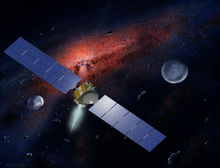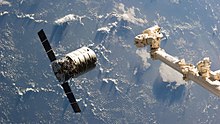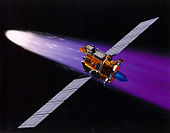

 | |
| Company type | Public |
|---|---|
| NYSE: ORB | |
| Industry | Space industry Aerospace industry Defense industry |
| Founded | 1982; 42 years ago (1982) Vienna, Virginia, U.S. |
| Founders | David W. Thompson Bruce W. Ferguson Scott L. Webster |
| Defunct | 9 February 2015 |
| Fate | Merged with Alliant Techsystems |
| Successor | Orbital ATK |
| Headquarters |
,
U.S.
|
Area served | Global |
Key people | David W. Thompson, Chairman, President and CEO Garrett E. Pierce, Vice Chairman and CFO Antonio L. Elias, Executive Vice President and CTO |
| Products | Space Launch Vehicles, Missile Defense Systems, Satellites and Related Systems, Advanced Space Systems, Space Technical Services |
| Revenue | |
| Total assets | |
| Total equity | |
Number of employees | 3,300+ (February 2014)[1] |
| Divisions | Launch Systems Group Space Systems Group Advanced Programs Group Technical Services Division |
| Website | www.orbital.com |
Orbital Sciences Corporation (commonly referred to as Orbital) was an American company specializing in the design, manufacture, and launch of small- and medium- class space and launch vehicle systems for commercial, military and other government customers. In 2014, Orbital merged with Alliant Techsystems to create a new company called Orbital ATK, Inc., which in turn was purchased by Northrop Grumman in 2018. The remnants of the former Orbital Sciences Corporation became a subsidiary of Northrop Grumman,[2] known as Northrop Grumman Space Systems.
Orbital was headquartered in Dulles, Virginia and publicly traded on the New York Stock Exchange with the ticker symbol ORB. Orbital's primary products were satellites and launch vehicles, including low Earth orbit (LEO), geosynchronous Earth orbit and planetary spacecraft for communications, remote sensing, scientific and defense missions; ground- and air-launched launch vehicles that delivered satellites into orbit; missile defense systems that were used as interceptor and target vehicles; and human-rated space systems for Earth orbit, lunar and other missions. Orbital also provided satellite subsystems and space-related technical services to government agencies and laboratories.[3]
On 29 April 2014, Orbital Sciences announced that it would merge with Alliant Techsystems to create a new company called Orbital ATK, Inc.[4] The merger was completed on 9 February 2015 and Orbital Sciences ceased to exist as an independent entity.[5]
On 18 September 2017, Northrop Grumman announced plans to purchase Orbital ATK for US$7.8 billion in cash plus assumption of US$1.4 billion in debt,[6][7] and on 6 June 2018, the acquisition was completed, and Orbital ATK became Northrop Grumman Innovation Systems.[8][9] As of 1 January 2020, the name was changed to Space Systems under a large restructuring and rebranding initiative.
Orbital was founded and incorporated in 1982 by three friends who had met earlier while at Harvard Business School — David W. Thompson, Bruce Walker Ferguson, and Scott L. Webster. Initial capitalization for Orbital was provided by Fred C. Alcorn, a Texas oilman and Sam Dunnam, a Texas businessman in September 1982. In 1985, Orbital procured its first contract for providing up to four transfer orbital stage (TOS) vehicles to NASA. In 1987, the seeds for the Orbcomm constellation were planted when Orbital began investigating a system using low Earth orbit (LEO) satellites to collect data from remote locations. In 1988, Orbital acquired Space Data Corporation in Arizona — one of the world's leading suppliers of suborbital rockets — thereby broadening its rocket business and manufacturing capabilities. This was followed by the opening of a new facility in Chandler, Arizona in 1989 to house the company's expanding rocket business.[10]
In 1990, the company successfully carried out eight space missions, highlighted by the initial launch of the Pegasus launch vehicle, the world's first privately developed space launch vehicle (the claim of being the first privately developed space launch vehicle can be contested as Pegasus received significant funding from NASA and DARPA, and a predecessor private rocket exists, the Conestoga rocket). Shortly following the successful Pegasus launch, Orbital conducted an initial public offering (IPO) in 1990 and began trading on the NASDAQ stock exchange. In 1993, Orbital established its headquarters in Dulles, Virginia. In 1994, Orbital successfully conducted the inaugural launch of the Taurus (now renamed as Minotaur-C) launch vehicle.
In the early 2000s, Orbital continued expanding its missile defense systems business with a US$900 million award to develop, build, test and support interceptor booster vehicles. In 2006, Orbital conducted its 500th mission since the company's founding with products that included satellites, launch vehicles, and missile defense systems. In 2007, the first interplanetary spacecraft built by Orbital, Dawn was launched on an eight-year, three-billion-mile journey to the main asteroid belt between Mars and Jupiter. A major milestone in the company's history was in 2008 when it received a long-term NASA contract to provide cargo transportation services to and from the International Space Station (ISS) with a value of approximately US$1.9 billion for missions from 2011 to 2015.[11] Orbital used its Cygnus spacecraft and Antares launch vehicle to transport cargo to ISS following the success of Cygnus Orb-D1 and Cygnus CRS Orb-1.
Orbital Science made a number of strategic acquisitions in the 1990s and 2000s to strengthen its position in the satellite market.
In 1994, Orbital completed acquisition of Fairchild Industries' subsidiary Space and Defense Corporation, and merged the Fairchild Space business with its own satellite design and manufacturing division.[12] The electronics business of this subsidiary was later sold off in 2000.[12]
In 1997, Orbital acquired CTA, Inc, a company that, under the spacecraft design engineering and business leadership of Tom van der Heyden - designer of the GEOStar spacecraft - had designed and built the first geostationary "lightsat" under contract to Indonesia for Asia's first Direct Broadcast Satellite (DBS) television broadcast program, and the world's first S-Band television broadcast satellite - providing an entry into the fast-growing Geosynchronous (GEO) communications satellite market.[13]
In 2010, Orbital acquired the Gilbert, Arizona-based satellite development and manufacturing unit from General Dynamics (General Dynamics Advanced Information Systems, formerly Spectrum Astro) to complement its main satellite manufacturing facility in Dulles, Virginia.[14]
On 29 April 2014, Orbital Sciences announced that it had entered into a definitive agreement with Alliant Techsystems to combine Orbital and ATK's Aerospace and Defense (A&D) Groups to create a US$4.5 billion (combined calendar year 2013 annual revenue), 13000-person company. The new company was called Orbital ATK, Inc.[4]
On 18 September 2017, Northrop Grumman announced plans to purchase Orbital ATK for US$7.8 billion in cash plus assumption of US$1.4 billion in debt.[6] Orbital ATK shareholders approved the buyout on 29 November 2017.[7] The Federal Trade Commission (FTC) approved the acquisition with conditions on 5 June 2018, and one day later, Orbital ATK were absorbed and became Northrop Grumman Innovation Systems.[8][9]

Orbital was a provider of small- to medium-class satellites. Since the company's founding in 1982, Orbital has delivered 150 spacecraft to commercial, military and civil customers worldwide. To date, these spacecraft have amassed well over 1000 years of on-orbit operations.[15]
The communications and imaging satellites developed by Orbital are smaller and more affordable. The geosynchronous orbit (GEO) communications satellites provide commercial satellite services such as direct-to-home digital television, business data transmission, cable program distribution and wireless communications. In addition, Orbital also provides constellations of low Earth orbit communications satellites such as the 35-satellite ORBCOMM data communications network, and the 81 spacecraft (integration and test) for the IridiumNEXT constellation. Earth imagery and high resolution digital imaging satellites such as the OrbView series are also developed and manufactured by Orbital.
The science and environmental satellites developed by Orbital perform scientific research, carry out deep space exploration (e.g. Dawn spacecraft), conduct remote sensing missions (e.g. Landsat 4, 5 and 8), and demonstrate new space technologies. In the last 10 years, Orbital has built more scientific and environmental monitoring satellites for NASA than any other company.[15]
Orbital's space launch vehicles are considered the industry standard for boosting small payloads to orbit. The Pegasus launch vehicle is launched from the company's L-1011 carrier aircraft, Stargazer and has proven to be the industry's small space launch workhorse, having conducted 40 missions from six different launch sites worldwide since 1990.[16]
The Minotaur ground-launched launch vehicles combine Pegasus upper-stages with either government-supplied or commercially available first-stage rocket motors to boost larger payloads to orbit. Minotaur IV combines decommissioned Peacekeeper rocket motors with proven Orbital avionics and fairings to provide increased lifting capacity for government-sponsored payloads.[16]
With the development of the Antares space launch vehicle, Orbital is extending its capabilities to provide medium-class launch services for U.S. government, commercial and international customers. The inaugural launch of Antares occurred on 21 April 2013 from Wallops Flight Facility (WFF) at Wallops Island, Virginia.[16]
Orbital is also a major provider of suborbital target and interceptor launch vehicles for the U.S. missile defense systems. In the last 10 years, Orbital conducted nearly 50 major launches for the U.S. Missile Defense Agency (MDA), the U.S. Air Force, the U.S. Army and U.S. Navy to develop, test and enhance U.S. missile defense systems.[16]

Orbital's Advanced Programs Group focused on developing and producing human-rated space systems, satellites and related systems for national security space programs, and advanced flight systems for atmospheric and space missions.[17]
In support of human space systems, Orbital is one of two companies providing commercial cargo resupply services to the ISS for NASA. Orbital's medium-class rocket - Antares is used to launch the Cygnus advanced maneuvering spacecraft to deliver cargo to the ISS. Under the Commercial Resupply Services (CRS) contract with NASA, Orbital will perform eight cargo missions to the ISS. Operational flights began in 2013 from the new Mid-Atlantic Regional Spaceport (MARS) at Wallops Island in Virginia. In addition, the company is exploring opportunities to adapt the Cygnus design for other possible space exploration applications.[17]
For National Security Space systems, Orbital provides products ranging from smaller, more affordable spacecraft busses to hosted payload applications. For Advanced Flight systems, Orbital is applying its to design and build an intermediate-class air-launched rocket system for Stratolaunch Systems. Orbital has developed the operational concept and completed the preliminary design for the air-launched rocket. It will be responsible for the development, production, test and operations of the full system and related ground operations.[17]
The Technical Services Division (TSD) provided engineering, production and technical management expertise primarily for space-related science and defense programs. Typically, it supplies specialized personnel — engineers, scientists, technicians and other professionals — with specific knowledge in the areas that its customers are pursuing. The Orbital employees often work side-by-side with the customers' technical staff at their facilities. They perform a wide range of functions, from system-level efforts such as special payload equipment and training support for NASA's Hubble Space Telescope servicing missions to component-level tasks including development of high-energy microwave transmitters for the National Radio Astronomy Observatory (NRAO).[18]
The TMS unit combined satellite navigation and wireless communications to enable transit control centers to manage the dispatch of public transit, highway service vehicles and commuter light rail systems. As of 2008, the technology was used by more than 60 clients, exceeding 27500 vehicles, or more than 30% of the United States and Canada fleet. TMS clients included some of the nation's largest fleet management systems, such as Los Angeles, Chicago, and Washington, D.C. In 2008, the technology services provider Affiliated Computer Services (ACS) Inc. agreed to buy the Transportation Management Systems unit for US$42.5 million. The sale transferred an estimated 130 to 140 Orbital employees based in Columbia, Maryland, to ACS.[19]
Orbital's primary locations are listed below-[20]


With the successful demonstration in September 2013 of the Cygnus spacecraft and the Antares launch vehicle under the Commercial Orbital Transportation Services (COTS) program, Orbital commenced regular ISS cargo missions under the Commercial Resupply Services (CRS) contract. The total NASA contract to Orbital is worth $1.9 Billion for providing eight pressurized cargo missions to the ISS.[28] Cygnus is capable of delivering 2,000 kg of pressurized cargo to the ISS. An enhanced version to be flown in later CRS missions is able to deliver 2,700 kg of pressurized cargo. The first of the eight contracted Cygnus missions to the ISS was completed on 18 February 2014. The October 28, 2014, launch failure was the third contracted Cygnus mission to the ISS.[29]
Orbital's Missile Defense Systems product line consists of interceptors and target vehicles.[30]
GEO communications satellites
With its proprietary GEOStar-2 satellite platform, Orbital has become a leading supplier of 1.5 - 5.5 kilowatt Geosynchronous-Earth Orbit (GEO) communications satellites used to provide direct-to-home TV broadcasting, cable program distribution, business data network capacity, regional mobile communications and similar services. With its new GEOStar-3 satellite platform, Orbital is extending its capabilities with up to 8 kW of total satellite payload power. The list of Orbital built GeoStar satellites are provided next.[32]
|
|
|
|
LEO communications satellites
Orbital is also a provider of low-Earth orbit (LEO) communications satellites, having conceived, built and deployed the ORBCOMM network. ORBCOMM was the first global communications network to employ a constellation of LEO satellites. From 1994–1999, Orbital built and deployed 35 satellites, and integrated five “gateway” ground stations and a network operations center to manage the satellites and process their data.
Under a contract with Thales Alenia Space, Orbital is conducting integration and test services for Iridium NEXT, the next-generation satellite constellation of Iridium Communications Inc. Orbital will integrate the communications payloads and platforms for 81 low-Earth orbit Iridium NEXT satellites and test the systems at its satellite manufacturing facility in Gilbert, Arizona.[32]
Orbital Imaging spacecraft are designed to provide commercial Earth imaging services. The OrbView series of spacecraft paved the way for today's space-based Earth imaging industry. In addition to the OrbView satellites the company also built the GeoEye-1 high resolution imaging satellite. Orbital LEOStar-2 and -3 spacecraft platforms are designed to support a variety of multispectral, visible and thermal imaging payloads. A list of commercial imaging satellites built by Orbital is provided next.[33]



Orbital built Science and Environmental satellites conduct astrophysics, Remote sensing/Earth Observation, heliophysics, planetary exploration and technology demonstration missions. These satellites are built on Orbital's LEOStar-1,-2, or -3 satellite platforms depending on the mission requirements and budget.[34]
Astrophysics satellites
Orbital's current and heritage astrophysics satellites are as listed below:
Remote sensing/Earth observation
Orbital's current and heritage Remote Sensing/Earth Observation satellites are as listed below:
Heliophysics
Orbital's heritage Heliophysics satellites are as listed below:
Planetary exploration
Orbital's heritage Planetary Exploration Heliophysics satellites are as listed below:
Orbital's national security systems range from smaller, more affordable spacecraft buses (e.g. disaggregated systems) to hosted payload applications.[35]
Orbital advocates disaggregated systems because conceptually disaggregated systems can lower the cost and accelerate the development and deployment of national security space systems. For example, Orbital's GEOStar-1 spacecraft provides a compact platform optimized for GEO missions (adaptable for MEO for launch aboard Minotaur, Falcon, and EELV launch vehicles to deliver resilient capabilities in a relatively short period of time (years instead of decades).[35] Orbital's hosted payload capabilities in national security systems include the Hosted Infrared Payload (CHIRP) program for the U.S. Air Force. The wide-field of view sensor was hosted on an Orbital-built commercial GEO communications satellite. Orbital's hosted payload program takes advantage of the high frequency of commercial satellite launches and the excess resources that typically exist on a commercial communications satellite to provide frequent and low-cost access to space for National Security Systems.[35]
Orbital's current advanced flight systems programs include the contract with Stratolaunch Systems to design a new intermediate-class rocket to be carried aloft and launched from the largest aircraft ever built-Stratolaunch carrier aircraft. Orbital is responsible for the program's overall systems engineering, and the development, production, test, and operations of the air-launch rocket and related ground operations, including payload and launch vehicle integration. A demo launch is currently scheduled for 2017. Orbital's heritage programs in advanced flight systems include the NASA X-34 and X-43 programs, and the Orion Launch Abort System, among others.[36]
Orbital has announced that it is planning to use another engine on Antares and that it will likely not use any more of the 40-year-old AJ-26 engines on the rocket's next flight – which Orbital hopes to conduct in 2016.
| International |
|
|---|---|
| National |
|